Machairas Troodos Cyprus
- Machairas monastery
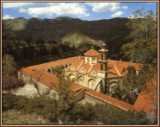 (large picture)
(large picture) 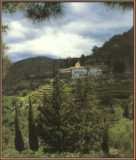 (large picture)
(large picture)
view of the Monastery
In the mountain forests of Machairas belonging to the Nicosia district there is a monastery dedicated to the Virgin Mary . It is called 'Machairotissa' after a famous icon kept there . It lies at about 870 metres above sea level close to the village of Lazanias and was founded at the end of the 12th. century .
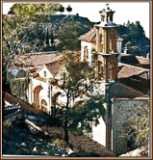 (large picture)
(large picture)
The church
Its history begins with an unknown hermit . In the time of the iconoclastic dispute in Byzantium , he brought one of the 70 icons , which are said to have been painted by the Apostle Luke , secretly from Asia Minor to Cyprus . After his death , the icon of the virgin remained in its hiding place until the arrival of two other hermits from Palestine in 1145 : Neophytos and Ignatios .
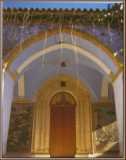 (large picture)
(large picture)
The church main entrance
According to tradition , the two monks found the icon in a cave . In order to reach it , they needed a knife (Greek 'machairi') so that they could cut away the undergrowth around the cave . It was given to them by ' divine hand ' . Accordingly , the icon of the Virgin Mary was called "Machairotissa " (and later also the monastery) . After the death of Neophytos , Ignatios travelled with another monk , Prokopios , to Constantinople before the year 1172 where they succeeded in obtaining financial assistance from the Byzantine emperor Manuel Komnenos . Back in Cyprus , they constructed a small church which was enlarged by the monk Neilos in the early 13th. century . He became the first abbot , later rising to become bishop of Tamasos .
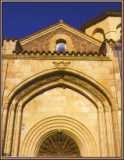 (large picture)
(large picture)
The church from the side
The Angeloi emperors Isaac and Alexios granted the monastery new privileges at Neilos's request : it was dispensed from tax payments . The abbot drafted the first rules which have applied since then for the monastic community . He was followed by Ioakeim , later Ioannes and Konon took his place . They came from Asia Minor to support the Orthodox in the struggle against the Latin intruders in the period of Lusignan rule .
 (large picture)
(large picture)
The Bell tower
Leontios , a monk from Machairas and author of the comprehensive work 'Exegesis of the enchanting land of Cyprus' , has left us written documents on the monastery and Frankish rule on Cyprus in the 14th. century . According to an inscription on a stone slab , the monastery burned down completely in 1530 . Just as in Kykkos , only the icon of the Virgin Mary survived this fire .
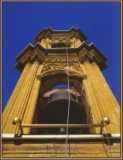 (large picture)
(large picture)
The Bell tower
Kleopas , a monk and calligrapher , makes mention of donations at the beginning of the 17th. century . In 1697 , during the period of office of Abbot Leontios II , the church was renovated . 23 years later , a monk of Arab origin , Parthenios , was elected abbot . He had come to Cyprus as a child and continued with the reconstruction of Machairas . Abbot Ioannikos (1766-1796) formed close spiritual , intellectual and economic links with Moldavia and Wallachia .
 (large picture)
(large picture)
The inside of the church
The Russian monk Basil Grigorovich Barsky visited the monastery in 1735 , noting in his diary : ' Machairas is one of the largest and most famous monasteries in Cyprus that belongs to the jurisdiction of the archbishop . Located like Kykkos on uneven ground , on the tops of the mountains , above a ravine . The monastery is rectangular in layout and covered with a tiled timber roof . In addition , it has two entrances , one of which is the main entrance facing towards the east , the second looks to the west . The main aisle of the church has wonderful propylaea with columns on the western side . It is covered by a dome and the large tiled roof which extends over the whole church . Inside the church are icons , chandeliers , stone floors and frescoes . There are only 25 monks ; they are extremely active and modest . They live mainly from agriculture and the donations of Christians .
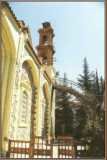 (large picture)
(large picture)
Side view
The monastery is surrounded by fresh air ; one well inside the walls and another outside supply healthy and fresh water . It is , it is true , located in a remote spot , but through its wide - spread fame the ungodly Moslems do not cease to call on the monks in order to frighten them . In the main aisle of the church , a small icon of the miraculous Mother of God encrusted with gold and silver is to be seen . This icon portrays the Virgin without her child with her hands raised in prayer - in the same way as I would draw her . '
Both in the period of Turkish rule and later , the monastery was well - known as a centre of the national intellectual life of the Cypriots . Just as elsewhere in the Christian world , a school was opened there in the 19th. century . Cyprus's folk medicine was practised mainly by the monk physicians Metrophanes and Charitos from Machairas . Metrophanes is known as the author of an 'Iatrosophion' , that is to say a work on the theory of medicine . In addition , especially in the recent past , the monastery was a centre for the production of liturgical books . Many of the works which came into being here are kept in the monastery library and the treasury .
The frescoes in the main part of the church were painted by Charalambos and Panagiotis Voulgaris from Amaliada in Greece in 1993 ; the mosaics on the right and left of the main portal of the church are by the contemporary Cypriot artist Arestis Stasis .

 (large picture)
(large picture)  (large picture)
(large picture) (large picture)
(large picture) (large picture)
(large picture) (large picture)
(large picture) (large picture)
(large picture) (large picture)
(large picture) (large picture)
(large picture) (large picture)
(large picture)

